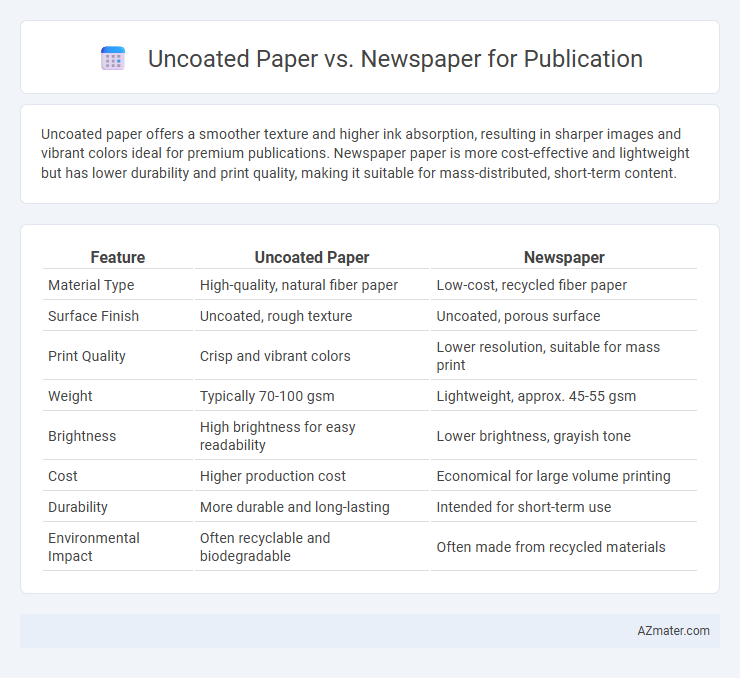Uncoated paper offers a smoother texture and higher ink absorption, resulting in sharper images and vibrant colors ideal for premium publications. Newspaper paper is more cost-effective and lightweight but has lower durability and print quality, making it suitable for mass-distributed, short-term content.
Table of Comparison
| Feature | Uncoated Paper | Newspaper |
|---|---|---|
| Material Type | High-quality, natural fiber paper | Low-cost, recycled fiber paper |
| Surface Finish | Uncoated, rough texture | Uncoated, porous surface |
| Print Quality | Crisp and vibrant colors | Lower resolution, suitable for mass print |
| Weight | Typically 70-100 gsm | Lightweight, approx. 45-55 gsm |
| Brightness | High brightness for easy readability | Lower brightness, grayish tone |
| Cost | Higher production cost | Economical for large volume printing |
| Durability | More durable and long-lasting | Intended for short-term use |
| Environmental Impact | Often recyclable and biodegradable | Often made from recycled materials |
Introduction to Uncoated Paper and Newspaper
Uncoated paper is a porous, absorbent material commonly used for high-quality printing requiring a natural texture and vibrant color reproduction. Newspaper paper, typically a low-cost, lightweight, and uncoated variant, is designed for mass production and rapid ink absorption to ensure legibility on large circulations. Understanding the differences in fiber content, weight, and finish between uncoated paper and newspaper paper is essential for selecting the appropriate substrate for publication purposes.
Key Characteristics of Uncoated Paper
Uncoated paper features a porous surface that absorbs ink quickly, offering a natural, matte finish ideal for high-quality, detailed printing. It has excellent readability due to its non-reflective surface and is often preferred for books, brochures, and art publications. Compared to newspaper, uncoated paper provides greater durability and a premium tactile experience, making it suitable for long-lasting publications.
Defining Newspaper Paper: Composition and Use
Newspaper paper is a low-cost, lightweight, and highly absorbent uncoated paper made primarily from recycled fibers and wood pulp, designed for quick ink absorption and fast drying. Its coarse texture and thin structure make it ideal for high-speed printing processes typical in newspaper production, ensuring legibility despite rapid printing. This paper's composition prioritizes cost-efficiency and recyclability, which distinguishes it from premium uncoated papers used in other publication formats.
Print Quality: Uncoated Paper vs Newspaper
Uncoated paper delivers superior print quality with sharper images and richer colors due to its smooth surface and higher ink absorption capacity, making it ideal for detailed and vibrant publications. Newspaper print quality is comparatively lower, characterized by coarser texture and more ink bleed, which leads to less sharp images and muted colors. The lower brightness and grainy finish of newspaper reduce contrast and clarity, impacting overall visual appeal for high-quality print demands.
Durability and Longevity Comparison
Uncoated paper exhibits higher durability and longevity compared to newspaper, as it resists yellowing and deterioration caused by exposure to light and air. Newspaper is typically printed on low-quality, highly acidic pulp that accelerates brittleness and fading within months or years. Choosing uncoated paper for publication ensures extended archival quality and sustained print integrity.
Cost Considerations in Publication
Uncoated paper typically costs more than newspaper-grade paper due to its higher quality fibers and lack of coatings, which increases production expenses. Newspaper paper is more economical for large-volume publications, offering lower unit costs despite its lower opacity and durability. Publishers must balance budget constraints with desired print quality when choosing between uncoated and newspaper paper for their projects.
Environmental Impact and Sustainability
Uncoated paper for publications typically has a lower environmental impact than newspaper due to its reduced use of chemical coatings and bleaches, resulting in easier recycling and biodegradability. Newspaper production often involves higher energy consumption and greater pollutant emissions, though many newspapers use high recycled content to improve sustainability. Choosing uncoated paper supports better lifecycle outcomes, promoting sustainable forestry practices and reducing landfill waste compared to conventional newspaper prints.
Reader Experience and Perceived Value
Uncoated paper offers a smoother texture and higher opacity, providing readers with a more tactile and premium feel that enhances text clarity and color vibrancy. Newspaper paper, typically thinner and rougher, can cause ink bleeding and reduced sharpness, which may diminish the overall reading comfort and perceived quality. Choosing uncoated paper elevates the publication's prestige and reader engagement, while newspaper stock prioritizes cost-efficiency over sensory appeal.
Suitability for Different Publication Types
Uncoated paper offers a smooth, natural texture ideal for high-quality brochures, books, and art catalogs where image clarity and tactile experience matter, while newspaper paper, typically low-cost and lightweight, suits mass distribution of daily news and advertisements due to its fast-drying ink absorption and economical production. Magazines and premium publications benefit from uncoated paper's ability to showcase rich colors and detailed graphics, whereas newspapers prioritize rapid print runs and cost-efficiency over texture and finish. Selecting between uncoated and newspaper paper depends on publication goals, desired print quality, and budget constraints.
Making the Right Choice for Your Publication
Uncoated paper offers a natural texture and higher absorbency, enhancing readability and color vibrancy for premium publication quality, while newspaper paper is cost-effective and designed for fast, high-volume printing with lower durability. Selecting the right paper depends on your publication's purpose, budget, and desired print longevity, with uncoated paper suited for upscale brochures and magazines and newspaper paper ideal for daily or weekly news distribution. Understanding key factors such as print clarity, tactile experience, and environmental impact ensures you make an informed decision tailored to your audience and brand image.

Infographic: Uncoated paper vs Newspaper for Publication
 azmater.com
azmater.com